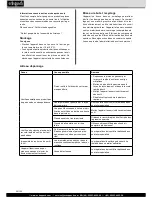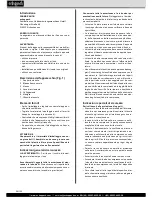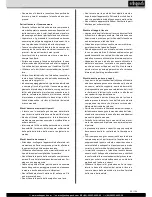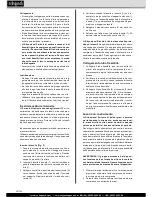
www.scheppach.com
+(49)-08223-4002-99
+(49)-08223-4002-58
17 І 124
www.scheppach.com
+(49)-08223-4002-99
+(49)-08223-4002-58
As soon as persons or animals enter the hazard ar-
ea, the operator must immediately stop the device and
ensure that these persons or animals are kept at an
adequate safety distance. The hazard area is always
dependent on the work and the tool. For this reason,
it is the responsibility of the operator to determine the
hazard area.
NOTE! The striking mechanism of the device only
operates when the tool is in contact with the mate-
rial to be processed. This function is designed to
protect the device against damage.
1. Press the trigger lever (4) to supply the impact
mechanism with compressed air and start the com-
pressed air device..
2.
Always hold the compressed air device with both
hands during work:
• Hold the compressed air tool with one hand on
the shaft (3) or handle (6) and the other hand on
the trigger lever (4)
3.
Note!
Hold the tool (7) against the material to be
worked. Do not operate the compressed air device
when it is not in contact with the material! Strokes
with no load lead to increased wear on the tool hex.
and on the sliding sleeve (2) of the tool receiver (1).
4.
The grip (6) and shaft (3) are used to guide the de-
vice and not to exert additional force on the mate-
rial. Only use enough muscle strength as is required
for the compressed air device to overcome the re-
sistance of the tool guide so that the impact drives
forwards and the compressed air device does not
jump up but rather works the material instead.
5. A limited degree of levering is possible. Too power-
ful levering can result in the shaft (3) or the tool (7)
breaking.
m
Risk of injury! Danger of stumbling
if the shaft or tool breaks, due to an unexpected
weight shift. Do not lever too severely.
6.
If you release the trigger lever (4), the compressed
air feed is interrupted. The compressed air device
stops with a brief run-on time.
m
Risk of injury!
Danger of extremely serious or even fatal inju
-
ries or damage to the device or tool if the trig
-
ger lever is permanently locked. Never lock the
trigger lever with cable ties, adhesive tape or
by other means
.
Check that the tool receiver has been furnished with an
oil film, after 2 hours of operation at the latest. If this is
not the case, introduce a few drops of special oil into the
connection hose. We recommend operating the com-
pressed air device in conjunction with a maintenance
unit with mist oiler as a matter of principle.
It is useful to grease the hex. tool receiver with large
pressing forces.
Excessive oil damps the impact performance. Drops
are forming on the trigger lever or on the tool receiver.
In this case, reduce the oil quantity on the oiler and
clean the device if necessary. Inadequate oil will result
in damage to the device and tool. Check oil feed and
top up oil or adjust oiler if required.
Inserting/replacing tool
m
Risk of injury due to tools! To insert or replace
tools, the device must be rendered pressure-less as
a matter of principle as otherwise the device could
be unintentionally started up if handled incorrect
-
ly. When dealing with sharp, pointed or hot tools,
always wear suitable protective gloves in order to
avoid injuries.
Use only original tools or tools that have been expressly
approved by the manufacturer for use with this com
-
pressed air device.
Inserting tool (fig. 2)
1.
Hold the compressed air device with the tool receiv-
er (1) upwards. Support the other end on the ground.
If the compressed air device has already been in
operation, check whether the tool receiver (1) is oily.
2.
Insert the tool (7) into the tool receiver (1) with the
hex. in the required orientation.
3. Slide the sliding sleeve (2) downwards with the other
hand until the tool (7) slides into the receiver. Guide
the sliding sleeve back into place again (2).
4. Pull the tool (7) to check that it is correctly latched
into the tool receiver (1). Check whether the hex. of
the tool (7) is positively locked into the tool receiver.
5.
Slide the sliding sleeve (2) halfway downwards.
6. Pull the tool (7) out with the other hand. Guide the
sliding sleeve back into place again (2).
m
Attention! Danger of injury through tools flying
out. Every time the tool is changed, ensure that
the tool receiver (1) has no signs of severe wear
or heavy impacts. Also, ensure that the hex. on
the tool is in flawless condition. After every tool
change, check that the tool is firmly seated.
Connect hose
1. Connect the hose (not included in the delivery) to
the compressed air source (e.g. on the compressor)
and open the compressed air feed.
2. Check the compressed air hoses and couplings
for leaks. In the event of leaks, interrupt the com-
pressed air supply and replace the hose!
3. Connect the hose (8) to the connection (5) on the
compressed air device (fig. 3). In doing so, ensure
that the compressed air device does not start up au-
tonomously. If this is the case, disconnect the com
-
pressed air coupling immediately. Have the com
-
pressed air device repaired by a specialist workshop
or the manufacturer.
Working with the device
m
Attention! Danger of extremely serious or even
fatal injuries if the device is pointed at people or an
-
imals and if persons or animals are located within
the hazard area - even if there is no tool fitted.
Never
point the device at people or animals. The operator is
personally responsible for ensuring that there are no
persons or animals in the hazard area of the device.












































